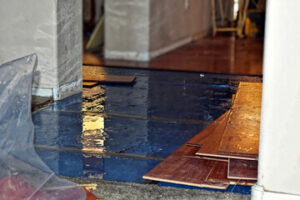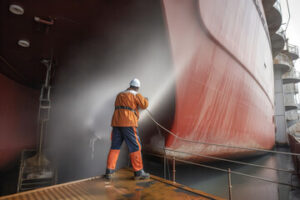Water Damage Restoration involves the cleaning, drying, and sanitizing of items that have been affected by water. It can be a major undertaking that requires special equipment like commercial-grade pumps, dehumidifiers, and fans.

Water damage is caused by a number of situations, including floods, storms, burst pipes, and sewage back-ups. The most serious cases require professional help. Visit https://www.infinity-construct.com/ for more details.
When a home or business experiences water damage, it can be a devastating event. However, there are professionals who can help restore the property and ensure that it is safe for use again. They will use a variety of methods to clean up the water, including dehumidification and structural drying. They will also remove any items that have been contaminated by the water and disinfect the area to prevent mold growth. Often, they will work with your insurance company to file a claim and make sure that everything is handled properly from start to finish.
One of the most important factors to look for in a disaster restoration service provider is IICRC certification. The IICRC is a widely recognized body that sets standards in the cleaning, inspection and restoration industry. Certification means that the professional has completed extensive training and passed a rigorous exam. This provides a high level of technical expertise and demonstrates a commitment to the industry.
The IICRC offers a variety of courses that address different aspects of the restoration and cleaning industries. For example, the Water Damage Restoration Technician (WRT) course teaches professionals how to perform practical remediation procedures that are related to specific types of disasters, such as sewer backflow and chemical spills. The Odor Control Technician (OCT) course teaches professionals how to identify and address odors that can be caused by a number of things, such as decomposition, chemical spills and smoke contamination.
IICRC certification benefits both professionals and consumers. For professionals, it increases their credibility, opens doors to new career opportunities and gives them access to a network of peers. It also helps them keep up with the latest trends, technology and tools in the field. For consumers, IICRC certification provides peace of mind, assurance that professionals are committed to upholding a code of ethics and will prioritize their safety during the restoration process.
If you are in need of help with a disaster restoration project, contact an IICRC certified expert. They will assess the damage and provide a free inspection and estimate. They will utilize air movers and dehumidifiers to draw out moisture and speed up the dry out process. They will also use specialized equipment to repair and replace damaged materials. They can even clean and disinfect areas that have been contaminated by hazardous substances, such as asbestos.
Remove Damaged Materials
Water damage can destroy cherished possessions and cause structural damage to the building. It can also create a health hazard, breeding mold and other pathogens. It doesn’t take long for standing water to begin causing irreversible damage, which is why it’s so important to act quickly when your home experiences any sort of water disaster.
The first step in a professional restoration process is usually water mitigation. This includes identifying the source of the water damage and stopping it from spreading. It also involves preserving items that can be saved, tarping off areas that can’t and taking other precautions to limit the extent of the water damage.
Once the water has stopped flowing, the next step in mitigation is removing the excess water from the property. This process is known as water extraction and it can be done using a variety of tools, including truck-mounted equipment. Water extraction is followed by dehumidification and temperature control to promote evaporation and prevent microorganism growth in the area.
When you are looking for a company to restore your home from water damage, it is important to find one that is licensed and certified. You should be able to check this information online and you can often find testimonials from previous clients to see how satisfied they were with the service. You should also look for a price range that fits your budget and try to find out if any discounts are available.
After the excess water has been removed, the professionals will start cleaning the affected areas. They will use special techniques to ensure that all moisture pockets are identified and addressed. This prevents long-term problems such as wood rot and mold growth. They will also disinfect the area with a specialized sanitizing solution.
It’s important to clean up as much as you can before the professionals arrive. For example, if you have a wet carpet, remove it and try to vacuum up as much of the moisture as you can. You should also try to ventilate the area as much as you can to get rid of any excess moisture. This will help to avoid mold and mildew growth.
Disinfect the Area
It doesn’t take long for mold, mildew and bacteria to grow in damp areas. Such pathogens present more than just a health risk to building occupants; they also threaten the structural integrity of the property.
This is why it’s crucial that water damage restoration services begin with a detailed inspection and assessment of the affected area, using advanced equipment like hygrometers to determine moisture levels. It’s then necessary to remove all the standing water, clean and disinfect surfaces that came into contact with floodwater, and dry and dehumidify the space.
It is important to use a professional service for this step, as they have the right tools to ensure all areas are thoroughly dried and sanitized. If you’re tackling this task yourself, remember to wear proper personal protective equipment (PPE) including safety glasses, rubber gloves, and a mask.
The goal is to get the area as dry as possible as quickly as possible, preferably within 24 hours. This can be achieved by running fans, using a commercial air mover or dehumidifier, and opening as many windows as possible to let in fresh outdoor air. It is also important to take rugs, bedding, clothing and other washable items outside to dry, as well as mopping floors and walls with a mixture of hot soapy water and bleach.
If you can’t take your belongings outside, be sure to place them on high surfaces away from floor vents, and keep them in a dark room or out of direct sunlight. This will help avoid the development of musty odors, which are often a sign of mildew and mold.
If you’re planning on returning to a flooded area, take photographs of the damage and keep an inventory of all damaged items. This will help you file a claim with your insurance provider if needed. Lastly, be sure to follow our blog post on safety in hazardous areas. This will protect you from germs, mold spores and chemicals used in cleaning and restoration processes.
Replace Damaged Materials
Once the area has been disinfected, it’s time to remove any materials that have been permanently damaged by water damage. This can include drywall, carpeting and other fabrics, baseboards, insulation and more. It’s important that these items are removed quickly to avoid any further damage and to speed up the drying process. Once all of these items have been removed, it’s time to replace them with materials that are moisture-resistant and will prevent mold growth.
When it comes to replacing these materials, it’s important that you find a water damage restoration company that is IICRC-certified. This organization sets the industry standards for mitigating and cleaning water-damaged properties. This means that they’ll follow the best practices and are up to date on the latest technologies. You can also rest assured that they’ll be able to provide you with high-quality, professional services at affordable prices.
During the inspection and assessment phase, professionals will use equipment like hygrometers to determine how much moisture is in the affected areas. They’ll then start by removing any standing water using truck-mounted extraction pumps. They’ll also use air movers and dehumidifiers to dry the property as fast as possible.
This step is particularly important for preventing further damage to the structure of your home. If a leak or flood is left untreated, it can lead to severe structural issues in your house. This is because moisture can cause wood to swell and warp. It can also cause drywall to buckle, wallpaper and paint to peel or blister, and even impact electrical systems in your home.
As a result, it’s essential that you contact professionals as soon as possible when you notice any signs of water damage. IICRC-certified technicians will be able to inspect your property for damage and identify the source of the issue. They’ll then take the necessary steps to repair and restore your property to its pre-loss condition. This is typically a five-step process that includes inspection and assessment, removal of water and contaminants, drying and dehumidification, cleaning and sanitizing, and replacement of damaged materials.

